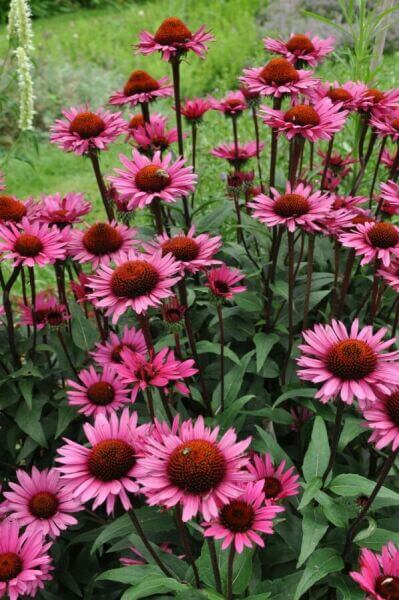Best Hedging Plants For Lush Borders
Improve your garden's attraction with lavish hedge varieties such as Yew (Taxus), Thuja, Laurel, Photinia, and Bamboo, celebrated for their structural integrity and ecological benefits.
Yew and Thuja supply evergreen protection and winter resilience, while Laurel uses rapid growth and broad, fragrant leaves.
Photinia adds seasonal charm with its vibrant red foliage, and Bamboo provides a low-maintenance, tranquil ambiance.
These hedges enhance air quality, decrease sound, and produce tranquil, personal spaces.
Appropriate planting, spacing, and upkeep make sure vigorous development and eco-friendly harmony.
Check out how these lush varieties can elevate your garden's beauty and wellness.
Key Takeaways
Transform Your Garden With Lush Hedge Varieties
- Select Yew for its thick, evergreen development and exceptional longevity.
- Go with Laurel for its quick growth and broad leaves, guaranteeing quick personal privacy.
- Choose Photinia for its dynamic seasonal foliage, which turns a striking dark red.
- Utilize Bamboo for a low-maintenance, winter-hardy hedge with aesthetic appeal.
- Area plants 2-3 per meter and prune regularly for ideal growth and health.
Popular Hedge Plants
When transforming a garden with lavish hedge ranges, it's necessary to think about popular hedge plants such as Yew, Thuja, Laurel, and Photinia due to their special characteristics and benefits.
Yew (Taxus) is extremely respected for its longevity and dense, green development, making it a prime choice for withstanding landscapes.
Thuja is kept in mind for its evergreen foliage and robust winter season resilience.
Photinia adds seasonal vibrancy with red leaves that darken over time, creating dynamic visual appeal.
Laurel uses quick growth and fragrant, broad leaves, ideal for quick privacy.
Furthermore, Bamboo is an outstanding choice for ambiance, providing a low-maintenance, winter-hardy choice that boosts the garden's aesthetic with its elegant, swaying walking canes.
These choices deal with a variety of horticultural requirements and preferences.
Benefits of Garden Hedges
Garden hedges use a multitude of advantages, making them an important addition to any landscape. These natural barriers are affordable to implement and supply substantial wind security, improving air circulation and adding to sound reduction. The thick foliage of hedges like Thuja and Beech ensures personal privacy by blocking visibility, developing a remote and peaceful environment.
Hedges also play a vital role in microclimate regulation, supplying a steady environment that promotes plant growth and decreases temperature variations. Their detailed leaf structures filter pollutants, enhancing air quality and contributing to a much healthier garden community.
Moreover, hedges stand out in noise decrease, soaking up and deflecting sound waves to lower ambient sound levels. This dual performance of providing both acoustic and visual privacy improves the total tranquility and visual appeal of any garden.
Planting and Upkeep Tips
For a successful hedge, precise preparation of the planting location is essential. Guarantee the soil has correct pH and drainage to support strong root development.
Area the plants properly for the chosen species. Water the hedge often throughout its initial growth phase, changing as required with seasonal changes.
Execute a methodical bug control and illness prevention technique, using chemical or organic treatments when essential. Routinely examine for aphids, termites, and fungal infections.
Apply mulch to maintain wetness and reduce weeds. Seasonal pruning promotes thick growth and air flow, necessary for plant health.
Following these standards will assist you cultivate a vibrant, well-kept hedge that improves the charm of your garden.
Spacing and Cutting Standards
Spacing and Trimming Standards
Proper spacing and trimming are important for cultivating healthy, aesthetically appealing hedges. Adequate spacing guarantees each plant gets enough nutrients, light, and airflow.
Follow these guidelines for ideal hedge upkeep:
- Spacing: Position hedge plants 2-3 plants per meter to motivate robust growth.
- Pruning Techniques: Regular pruning is important for maintaining desired hedge height and shape. Trim brand-new development in summer season and cut down older wood throughout winter.
- Seasonal Care: Adjust trimming schedules and methods according to seasonal requirements to make sure plant health.
- Hedge Height: Frequently screen and trim to maintain the wanted hedge height and attain consistent aesthetic appeals.
Adhering to these actions will ensure your hedge grows, boosting both the appeal and performance of your garden.
Choosing the Right Hedge
Picking the Right Hedge
Choosing the suitable hedge involves examining Additional info elements such as mature height, foliage density, and environmental resilience. Successful hedge plant choice needs comprehending each species' development qualities and site-specific adaptability.
For example, Yew (Taxus) provides outstanding longevity and thick development, while Thuja is notable for its winter season durability. Furthermore, considering upkeep requirements is essential; fast-growing types like Laurel or Privet need routine trimming, whereas low-maintenance alternatives like Bamboo or Ivy might be preferable for those looking for minimal upkeep.
Environmental elements such as soil type, light accessibility, and moisture conditions need to also assist the selection procedure. This careful approach guarantees the picked hedges will flourish, supplying both visual and functional advantages to the garden landscape.
Delivery and Planting Advice
To guarantee your hedge plants grow, they must be provided by specialized couriers and planted promptly upon arrival.
Follow these important actions for effective planting:
- Soil Preparation: Enrich the soil with raw material to improve drain and nutrient content.
- Planting Depth: Develop a trench two times the width and equivalent to the depth of the root ball.
- Watering Techniques: Water completely after planting, keeping the soil consistently damp however not filled.
- Mulching: Apply a layer of mulch to keep wetness and suppress weeds.
Client Assistance and Service
Provided the crucial function of timely assistance in horticultural pursuits, our client assistance group is readily available 6 days a week through telephone, e-mail, and social media to offer professional guidance and quickly attend to any concerns. Their devotion to fast response times ensures customer complete satisfaction by solving questions related to plant health, optimal planting approaches, and upkeep schedules.

Schedule
-------------------
Within 24 hours
This thorough support group, reinforced by a stellar 9.3/ 10 client score, highlights our dedication to enhancing the gardening experience for every client.
Frequently Asked Questions
How Long Does It Consider Hedge Plants to Establish?
Hedge plants generally require one to three years to become fully established, with the exact duration differing by types and growing conditions.
Reliable care throughout this important duration is necessary for robust growth. Consistent watering, vigilant weed control, and appropriate fertilizer application are essential in promoting strong root development.
For example, fast-growing species like Laurel may establish faster, while slower-growing ranges such as Yew may take longer. Persistent maintenance speeds up the establishment process, resulting in thick and healthy hedges.
What Are the Best Hedge Plants for Personal Privacy?
The concern of the best hedge plants for privacy includes evaluating evergreen and deciduous choices.
Evergreen hedges like Thuja, Laurel, and Cypress offer year-round coverage, ensuring constant personal privacy.
In contrast, deciduous hedges such as Beech offer seasonal personal privacy, shedding leaves in chillier months.
Key upkeep ideas for privacy hedges consist of routine trimming, fertilizing in spring, and correct spacing-- generally 2 to 3 plants per meter.
Furthermore, constant watering and thorough weed elimination are essential for promoting healthy, dense development.
Can Hedge Plants Attract Wildlife to My Garden?
Yes, hedge plants can bring in wildlife to your garden by providing vital benefits like shelter, food, and nesting websites, thus boosting local biodiversity. Yew, holly, and laurel are exceptional for attracting birds, while ivy supports a range of insects.
Nevertheless, it is necessary to keep in mind that there are some drawbacks, such as increased upkeep to handle insects and regular upkeep. Thoroughly selecting and preserving hedge ranges can help balance these disadvantages and advantages, ultimately promoting a lively and sustainable community in your garden.
Exist Any Flowering Hedge Plants Available?
Yes, there are flowering hedge plants offered that can improve the appeal of your garden.
For example, Elaeagnus, likewise called Olive Willow, produces fragrant white flowers in the fall, adding a touch of beauty.
Photinia, another popular option, showcases dynamic red leaves that grow into an abundant green, creating a dynamic visual result throughout the seasons.
To ensure these plants grow, it's important to practice proper pruning strategies and seasonal upkeep, such as trimming new growth in the summer and cutting down in the winter season.
These measures will assist preserve the health and aesthetic appeal of your flowering hedges.
How Do I Prevent Pests in My Hedge Plants?
To prevent insects in hedge plants, employ natural pest control methods and maintain appropriate hedge care. Introduce useful pests like ladybugs, which take advantage of damaging bugs, to develop a well balanced environment.
Frequently check your hedges for indications of infestation and quickly eliminate any affected parts to prevent the spread. Ensure the health of your hedges by applying balanced fertilizers and offering sufficient water.
Utilize mulching to retain soil moisture and correct spacing to lower plant tension and promote robust development. These practices collectively help in minimizing bug concerns and keeping a healthy hedge.
Conclusion
In essence, selecting the right hedge varieties such as Yew, Thuja, and Laurel can change any garden into a relaxing haven. These plants supply year-round plant, improve aesthetic appeal, and offer useful benefits like noise decrease and wind defense.
Appropriate planting techniques, precise spacing, constant watering, and seasonal trimming are vital for optimum growth.
Reputable delivery services and skilled client support guarantee a seamless experience from purchase to planting, making it easier than ever to raise your outdoor area.
Garden hedges offer a plethora of benefits, making them an important addition to any landscape. These natural barriers are economical to implement and offer considerable wind defense, improving air circulation and contributing to noise decrease. The dense foliage of hedges like Thuja and Beech makes sure privacy by blocking visibility, developing a remote and serene environment.

Pruning Techniques: Regular pruning is necessary for preserving preferred hedge height and shape. Cut brand-new growth in summer and cut back older wood throughout winter.
 Michael Fishman Then & Now!
Michael Fishman Then & Now! Danielle Fishel Then & Now!
Danielle Fishel Then & Now! Earvin Johnson III Then & Now!
Earvin Johnson III Then & Now! Dolly Parton Then & Now!
Dolly Parton Then & Now! Megyn Kelly Then & Now!
Megyn Kelly Then & Now!